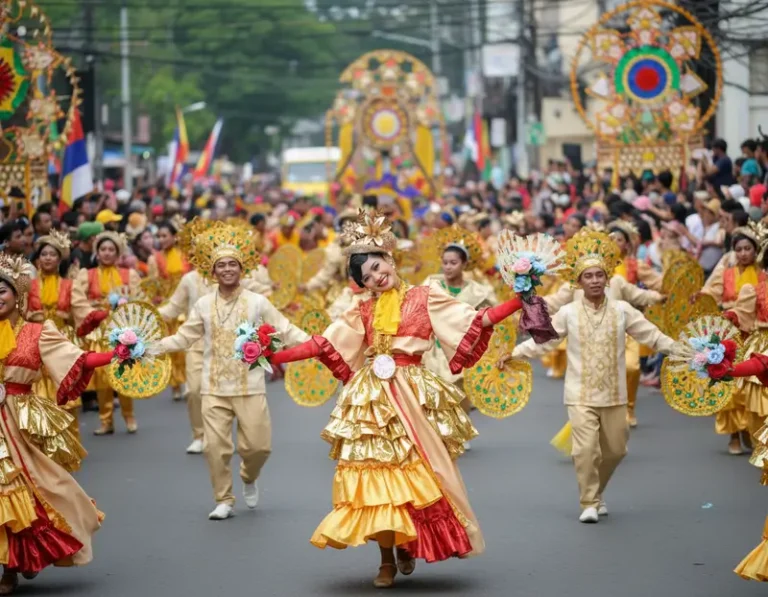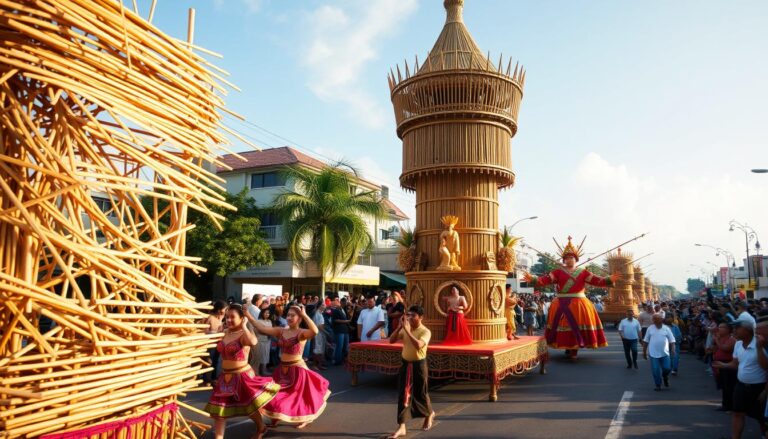Sulyog Festival
Sulyog Festival: A Celebration of Faith, Food, and Farming
What Makes This Festival So Special?
Have you ever heard of a festival that celebrates bananas, coconuts, and religion all at the same time? That’s exactly what happens in Bongabong, Oriental Mindoro, every March! The Sulyog Festival is a vibrant celebration that brings together the whole community to honor their agricultural heritage and their deep faith in St. Joseph.
The Name Tells a Story
The word “Sulyog” comes from the Mangyan language and combines two words:
- Suly = banana
- Og = coconut
These two fruits are super important to the people of Bongabong because farming has been their way of life for hundreds of years.
What Happens During the Festival?
Street Dances and Parades
The most exciting part? The Indak San Jose street dance! This colorful parade brings the streets to life with dancers in traditional costumes. You’ll also see a lechon parade (that’s roasted pig for those new to Filipino cuisine) that shows off all the delicious local food.
Religious Events
For nine days before the festival, people attend novena masses—special prayers honoring St. Joseph. The celebration ends with a beautiful fluvial parade on the water, combining spiritual traditions with modern fun.
Cultural Performances
Traditional cultural dances tell stories about farming life and showcase the skills farmers have learned from their families for generations.
Why Visit?
The Sulyog Festival is more than just a party—it’s a chance to see how communities keep their traditions alive while celebrating what matters most to them: their faith, their food, and their farming heritage.
Origins and Cultural Significance
Origins and Cultural Significance
What Makes the Sulyog Festival So Special?
Have you ever wondered how a small town celebrates where it comes from? Well, in Bongabong, Oriental Mindoro, the Sulyog Festival does exactly that! This vibrant celebration honors the town’s farming history and shows gratitude for good harvests and blessings from nature.
Where Did the Festival’s Name Come From?
The name “Sulyog” comes from two important words in the Mangyan language:
- “Suli” = Banana
- “Niyog” = Coconut
These two crops have been the heart of farming in this region for generations. They’re not just foods—they’re part of the community’s identity and survival.
How Does the Festival Keep History Alive?
The Sulyog Festival showcases amazing cultural dances that tell stories about farming. These performances aren’t just entertainment—they’re like living textbooks that show:
- Traditional ways farmers harvest crops
- How communities gather copra (dried coconut meat)
- Skills passed down from parents to children for hundreds of years
- Respect for the land and its gifts
Connecting Past and Present
By mixing cultural traditions with agricultural practices, the Sulyog Festival creates a bridge between yesterday and today. It celebrates both the heritage of Bongabong and the strong sense of community that brings people together.
The festival reminds everyone that farming isn’t just a job—it’s part of who they are.
Religious Traditions and Devotion to St. Joseph
Religious Traditions and Devotion to St. Joseph
Did You Know? A Community’s 389-Year-Old Faith Story
Have you ever wondered how a small farming village keeps its traditions alive for almost 400 years? In this community, Sulyog celebrates both crops and faith, all thanks to deep devotion to St. Joseph that began centuries ago.
How It All Started
A church near Bongabong River was established by Jesuits and later led by Augustinian Recollects.
Then, in 1938, St. Joseph Parish Church was officially founded.
That’s a long time of people gathering, praying, and celebrating together!
Religious Traditions That Bring People Together
The Sulyog festival showcases meaningful spiritual celebrations that connect residents to their faith:
Prayer and Spiritual Reflection
- Community prayers held at St. Joseph Parish Church
- Novena masses (nine days of special prayers leading up to the celebration)
Processions and Parades
- Grand religious processions through the community
- Fluvial parades on March 18 (St. Joseph’s feast day) that travel on water
Cultural Street Celebration
– Indak San Jose street dance that honors the patron saint through music and movement
Why These Celebrations Matter
These religious traditions don’t just happen randomly.
They unite the entire community in gratitude and joy.
People blend their spiritual devotion with cultural celebration, creating something special that reflects their values and history.
It’s how faith and community traditions stay strong across generations.
Festival Events and Activities
Festival Events and Activities
Ever wonder what happens when a whole town celebrates together?
From March 15 to March 19, the municipality of Bongabong comes alive with an amazing festival that brings people together.
This isn’t just any celebration – it’s a special event where religion, fun, and community spirit all mix together in one exciting week.
What Makes This Festival Special?
Street Dancing and Parades
The highlight is the Indak San Jose street dance, where performers dress up and dance through the streets to honor St. Joseph.
If you love watching people perform and move to music, this is something you won’t want to miss.
Fun Competitions and Celebrations
- Talent contests where locals show off their skills
- Mass weddings bringing couples together
- The famous Lechon Parade celebrating local food
Support Local Businesses
A trade fair sets up shop during the festival, giving local artisans and craftspeople a chance to sell their handmade items.
It’s the perfect place to find unique, one-of-a-kind products while helping your community.
The Grand Finale
On March 18, the festival reaches its climax with a grand procession and fluvial parade (that’s a water parade!).
These final events wrap up the novena celebrations – a special nine-day religious tradition.
The Bottom Line: This festival proves how a community can blend tradition with modern celebration, creating memories that last long after the music stops.
Getting to Bongabong, Oriental Mindoro
Getting to Bongabong, Oriental Mindoro: Your Complete Travel Guide
Ready for an adventure? Once you’ve heard about all the amazing things happening at Sulyog Festival, it’s time to figure out how to actually get there! Don’t worry—reaching Bongabong is easier than you might think.
How to Get There
The Main Route:
- Take a ferry from Manila to Batangas port.
- From Batangas, continue your journey to Oriental Mindoro.
- This is the most popular way visitors travel to Bongabong.
Other Options Available:
If the main route doesn’t work for you, several alternative ports can get you to this exciting Oriental Mindoro destination:
- Bulalacao port.
- Dangay port.
- Muelle port.
- Balatero port.
Making Your Journey Easy
Public transportation services connect all these ferry routes, so you can travel comfortably without stress.
The local government works hard to make sure the roads and ports are in great shape for tourists like you.
How Long Does It Take?
Travel time depends on which route you choose and what type of transportation you use.
Some routes are faster than others, but all of them will get you to Bongabong ready to celebrate!
Once you arrive, you’ll experience incredible cultural celebrations, meet friendly locals, and feel the true community spirit that makes Sulyog Festival special.
Planning Your Visit
Planning Your Visit to Sulyog Festival
When Should You Go?
Are you ready for one of the most exciting celebrations in the Philippines? The Sulyog Festival happens every year from March 15 to March 19, with the biggest celebration on March 18.
This is the perfect time to experience Bongabong’s unique culture and traditions!
Book Your Stay Early
Here’s something important: hotels get packed really fast during festival time.
You’ll want to:
- Reserve your accommodations weeks ahead
- Check multiple hotels and lodges in town
- Look into guesthouses if hotels are full
- Book online to get the best deals
Taste Amazing Local Food
One of the best parts of visiting? The food!
You can find delicious treats everywhere:
- Traditional dishes that show off Bongabong’s farming heritage
- Food stalls with snacks and quick bites
- Restaurants serving authentic local cuisine
- Special festival foods you won’t find anywhere else
Take Home Special Souvenirs
Want to remember your trip forever?
Pick up these awesome keepsakes:
- Handmade handicrafts from local artists
- Coconut-based products unique to the region
- Festival merchandise and commemorative items
Pro Tips for the Best Experience
The Municipal Government of Bongabong suggests arriving early on festival days.
Why? You’ll snag the best spots for watching the procession and the beautiful fluvial parade on the water.
Getting there first means you won’t miss a single moment of this unforgettable celebration!






